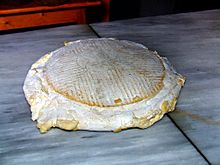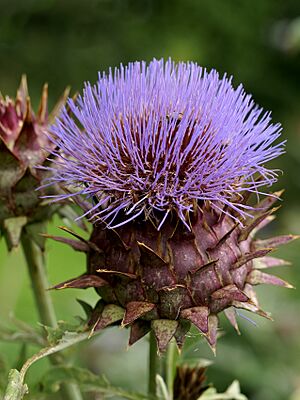Flor de Guía cheese facts for kids
Quick facts for kids Flor de Guía |
|
|---|---|
 |
|
| Country of origin | Spain |
| Region | Gran Canaria |
| Town | S.Maria de Guía, Moya and Gáldar |
| Source of milk | Cow, sheep and goat |
| Texture | semi-hard to soft |
Flor de Guía cheese is a special type of cheese from the Canary Islands in Spain. It's made on the island of Gran Canaria. This cheese has a special protection called "Denomination of Origin." This means it can only be made in a specific area using traditional methods.
Flor de Guía cheese is mostly made from the milk of Canarian sheep. Sometimes, milk from Canarian cows or goats is added too. At least 60% of the milk must come from sheep. Cow's milk can't be more than 40%, and goat's milk can't be more than 10%.
This cheese is usually flat and round. It's about 4–8 cm (1.5-3 inches) tall and 20–30 cm (8-12 inches) wide. Each cheese weighs between 2 and 5 kg (4.5-11 pounds). The name "Flor de Guía" comes from two things: "Guía" is a town in northern Gran Canaria where the cheese is made. "Flor" means "flower" in Spanish. This is because juice from special flowers, like the cardoon and globe artichoke, is used to help the milk turn into cheese.
Contents
How Flor de Guía Cheese Is Made
Flor de Guía cheese is made in three main types. The difference is in how the milk is curdled, which means how it turns into solid cheese.
- Flor de Guía: This type uses only the juice from cardoon flowers to curdle the milk.
- Half Flor de Guía: This one uses a mix. It's 50% cardoon flower juice and 50% globe artichoke flower juice.
- Guía Cheese: This type uses some plant-based curdling agents and some animal-based ones. These animal agents often come from young goats or lambs.
Cheeses can also be "semi-cured" or "cured." This just means how long they have been aged.
The cheese is only made in a few towns: Santa María de Guía, Moya, and Gáldar. It's also a seasonal cheese, meaning it's only made from January to July.
The milk comes from sheep that roam freely in pastures. They eat wild plants and grass. Cows are usually kept in barns but can graze outside when the weather is good. Goats graze in fenced areas and are brought inside at night. The animals can be milked by hand or with machines.
To make the cheese, salt is added to the milk. Then, the special flower juice or other curdling agents are added. The milk is gently heated and left to sit. This process helps the milk form solid curds.
Once the curds are ready, they are cut into small pieces, like rice grains or chickpeas. The curds are then put into special molds. These molds often have designs inside that create a flower shape on the cheese's rind. More salt is sprinkled on the cheese. The cheese stays in the mold for about 24 hours.
After molding, the cheese needs to age for at least 15 days, but sometimes up to 60 days. During this time, the cheeses are turned regularly and smoothed. Sometimes, they are rubbed with olive oil to help them age. Older cheeses might have paprika or gofio (a type of flour) rubbed on their outside.
What Flor de Guía Cheese Tastes Like
Flor de Guía cheese tastes creamy and a bit salty. The exact flavor can change slightly depending on the mix of milks used. It doesn't have a super strong taste. It can sometimes be a little bit tangy or spicy.
How Flor de Guía Cheese Feels
The cheese has a firm, dense texture with no holes inside. It can feel firm or soft, depending on how long it has aged. The color ranges from ivory-white to yellow, also depending on its age.
The Rind of the Cheese
The rind (the outside skin) of Flor de Guía cheese can be dark brown on older cheeses. On younger cheeses, it's usually ivory-white or cream colored. The rind gets thicker as the cheese ages. Some cheeses have a flower design on top, while others don't.
Images for kids
See also
 In Spanish: Queso flor de Guía para niños
In Spanish: Queso flor de Guía para niños




